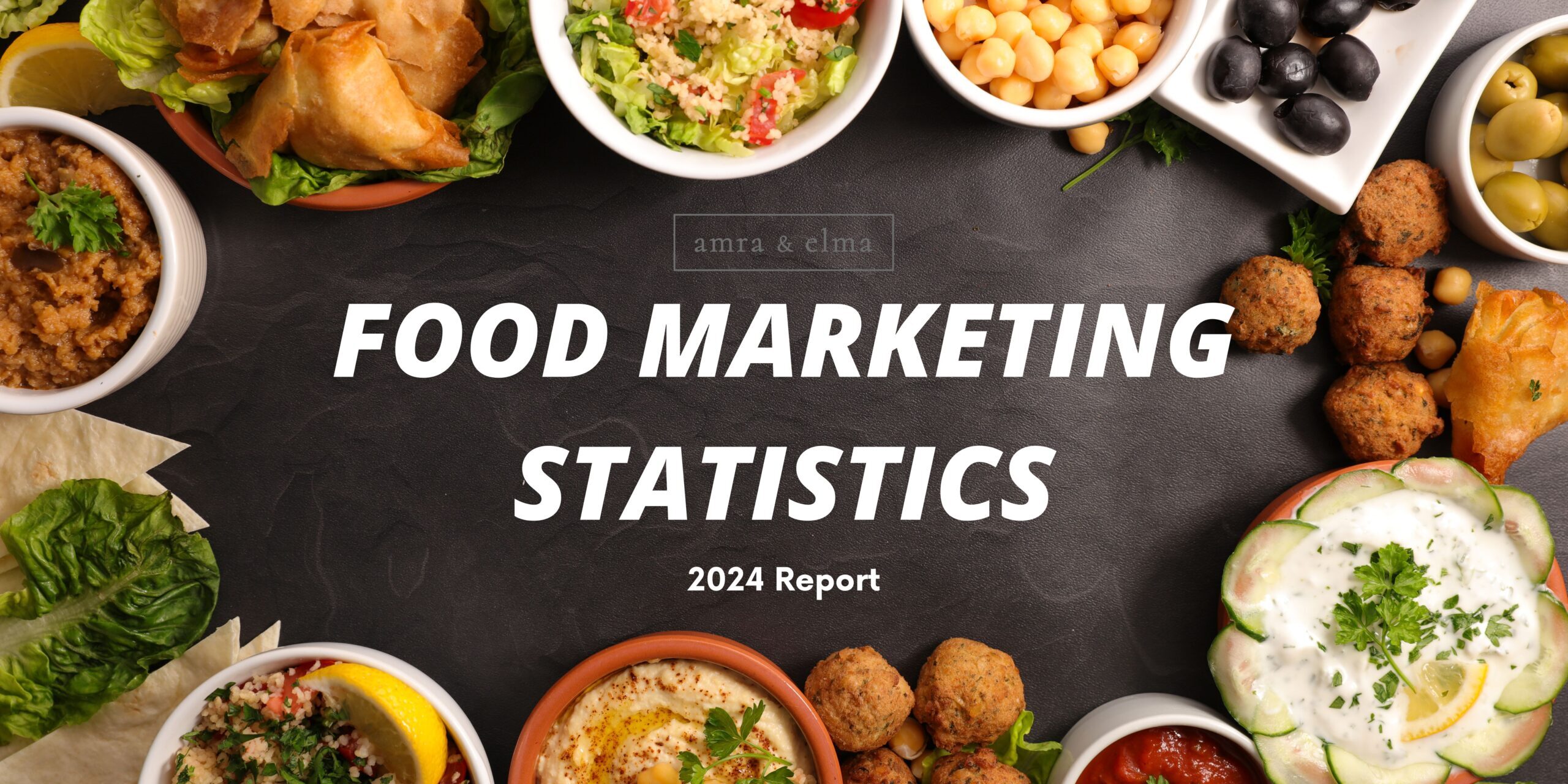
02 Jun FOOD MARKETING STATISTICS IN 2024
In 2024, according to Statista, the global food industry is expected to reach over $10 trillion, reflecting a consistent growth trend observed over the past few years, see chart below. This substantial market encompasses a wide array of companies involved in promoting and selling food products, ranging from multinational corporations to local producers and retailers. Notable players in the food marketing industry include industry giants such as Nestlé, PepsiCo, Coca-Cola, Kraft Heinz, and Unilever, which utilize diverse marketing strategies to engage with consumers and drive sales. For instance, according to another finding by Statista, Nestlé, a Swiss food and drink company, emerged as the largest advertiser in the United States for food and beverages, investing approximately $2.4 billion U.S. dollars in advertising across all channels in 2022. Another notable fact is that amidst evolving consumer preferences and behaviors, digital ordering and delivery have surged, outpacing traditional dine-in traffic by 300% in recent years. Furthermore, emerging trends such as food influencer marketing have reshaped the landscape, emphasizing the importance of understanding current food marketing statistics and insights to remain competitive in the industry. With the dynamic nature of the food market, staying informed about key trends and statistics is crucial for businesses aiming to capitalize on emerging opportunities and navigate challenges effectively.
Below, we delve into 25 essential food marketing statistics for 2024, offering insights into consumer behavior, industry trends, and marketing strategies.
Food Marketing Statistics (Editor’s Choice)
- Digital ordering and delivery has grown 300% faster than dine-in traffic since 2014
- Food Influencer marketing is expected to grow at a rate of 42% between 2019 and 2024
- The average conversion rate for search ads in the food and beverage industry is 2.5%
- 92% of consumers read restaurant reviews before making a decision about where to eat
- A half-star difference on a Yelp review rating can swing restaurant business by a whopping 27%
- Nestlé is the biggest food advertiser in United States with $2.4 billion invested in advertising in 2022
Food Marketing: 25 Top Food Marketing Statistics in 2024 (Updated)!
Food Marketing Statistics #1: Search engine marketing is the most popular digital marketing strategy in the food industry, with an ad spend of $5.5 billion.
According to CommonThread, search engine marketing is the most popular digital marketing strategy among food and beverage companies, with an ad spend of $5.5 billion in 2021. Social media marketing is the second most popular digital marketing strategy among food and beverage companies, with an advertising spend of $3.5 billion in 2021. These numbers are expected to grow in the coming years as more and more companies invest in digital marketing. The benefits of digital marketing are clear: it allows companies to reach a wider audience more efficiently and effectively than traditional marketing methods. Additionally, digital marketing is highly customizable, allowing businesses to target specific groups of consumers with laser precision. As the food and beverage industry becomes increasingly competitive, companies need to invest in effective digital marketing strategies.
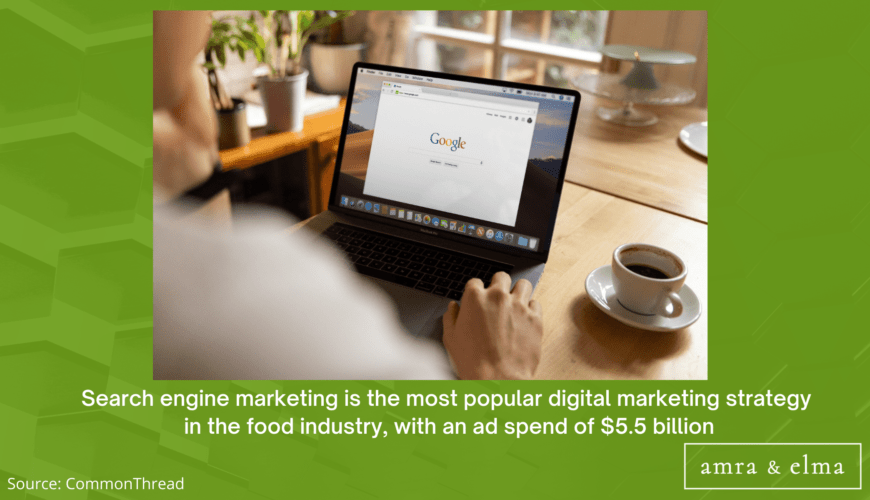
Food Marketing Statistics #2: The average conversion rate for search ads in the food and beverage industry is 2.5%.
According to the Smart Insights “E-Commerce Conversion Rates Benchmark Report,” the average conversion rate for search ads in the food and beverage industry is 2.5%. In 2021, the average cost-per-click for search ads in the food and beverage industry was $0.58. While these numbers may seem small, they can significantly impact a company’s bottom line. For example, a company that spends $1,000 on search ads with a 2.5% conversion rate will generate $25 in revenue. However, if that same company spends $1,000 on search ads with a 5% conversion rate, it will generate $50 in revenue. Even a slight increase in conversion rate can significantly impact a company’s overall performance.

Food Marketing Statistics #3: Food Influencer marketing is expected to grow at a rate of 42% between 2019 and 2024.
According to eMarketer, food influencer marketing is expected to grow at a rate of 42% between 2019 and 2024. This growth is being driven by several factors, including the increasing popularity of social media, the growing number of food-focused influencers, and the growing interest of brands in reaching consumers through these channels. As a result, we can expect to see more food-related content on our feeds in the coming years. And while some may view this as a trend that will eventually die out, it’s important to remember that influencer marketing is still in its early stages. This means that there is still plenty of room for growth and innovation. So whether you’re a foodie looking for new content to consume or a brand looking to reach a new audience, keep an eye on food influencer marketing – it’s only going to get bigger and better.

Food Marketing Statistics #4: 90% of guests research a restaurant online before dining—more than any other business type.
According to the latest data from Upserve, 90% of guests research a restaurant online before dining—more than any other business type. 57% of those guests viewed restaurant websites before selecting where to dine. This indicates that having an up-to-date and well-designed website is critical for any restaurant that wants to attract new guests. Furthermore, the website should be optimized for search engines so that potential diners can easily find it when searching for restaurants in their area. By taking these steps, restaurants can ensure that they are reaching the broadest possible audience and making it easy for new guests to find them.
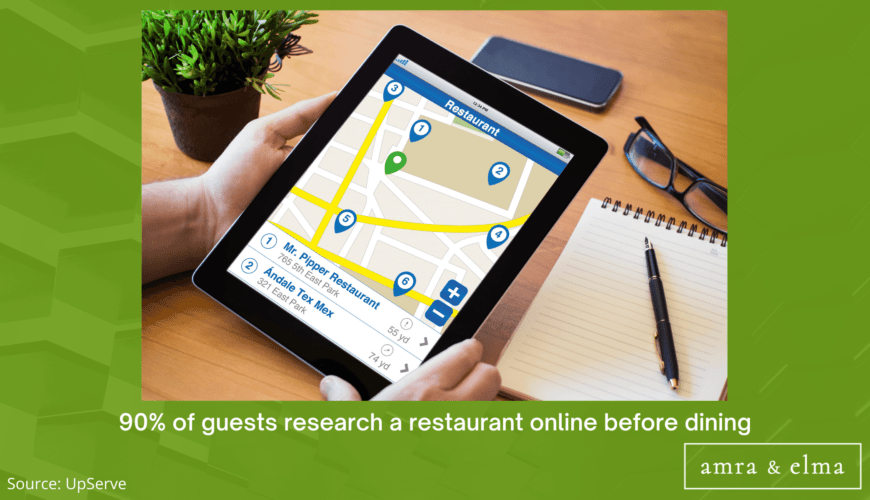
Food Marketing Statistics #5: 92% of consumers read restaurant reviews before making a decision about where to eat.
According to a customer survey from BrightLocal, 92% of consumers read restaurant reviews before deciding where to eat. This percentage has been steadily increasing in recent years, as the internet has made it easier than ever to find and share reviews. A single bad review can deter customers from dining at a restaurant, so businesses need to monitor their online reputation. One way to do this is to encourage happy customers to leave positive reviews on popular sites like Yelp and Google Maps. Restaurants can also reach out to unhappy customers directly to try and resolve any issues. Businesses can help ensure that potential diners have a positive impression of their restaurant by taking these steps.

Food Marketing Statistics #6: 33% of US customers would never eat at a restaurant with less than four stars.
According to a customer survey from UpServe, 33% of US customers would never eat at a restaurant with less than four stars. This suggests that customers place high importance on ratings when choosing a restaurant. Many factors can contribute to a restaurant’s rating, including the quality of the food, the cleanliness of the dining area, and the friendliness of the staff. However, one of the most critical factors is value for money. Customers want to feel like they are getting their money’s worth, and if they don’t, they are likely to give the restaurant a low rating. As a result, restaurants need to offer good value to attract and retain customers.
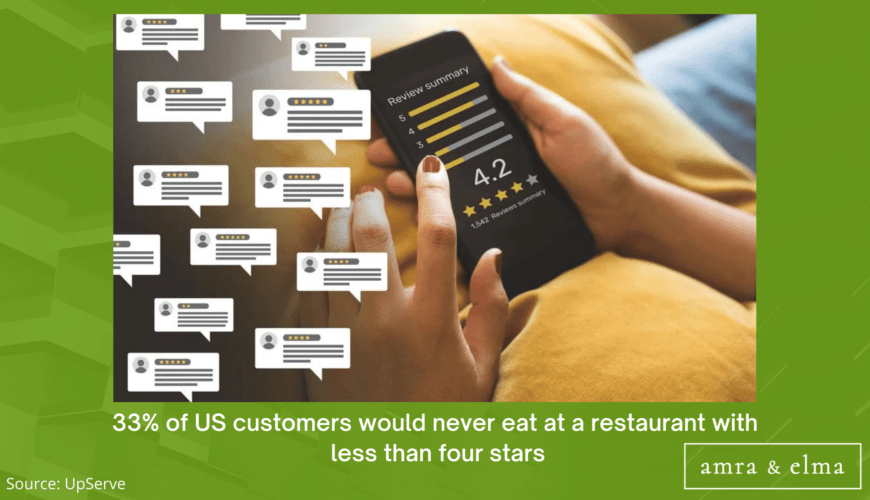
Food Marketing Statistics #7: A half-star difference on a Yelp review rating can swing restaurant business by a whopping 27%.
A report from FoodBeast found that a half-star difference on a Yelp review rating can swing restaurant business by a whopping 27%. The report analyzed data from over 6,000 restaurants in 10 major cities across the United States. They found that, on average, each additional star on Yelp led to a 5-7% increase in business. This may not seem like much, but it can make a big difference for companies on the borderline of a two or three-star rating. The report found that restaurants with a three-star rating were 27% more likely to be fully booked than those with a two-star rating. Given the power of online reviews, it’s no wonder that businesses are willing to go to great lengths to get positive reviews. However, it’s important to remember that reviews should always be honest and accurate to maintain the ratings system’s integrity.
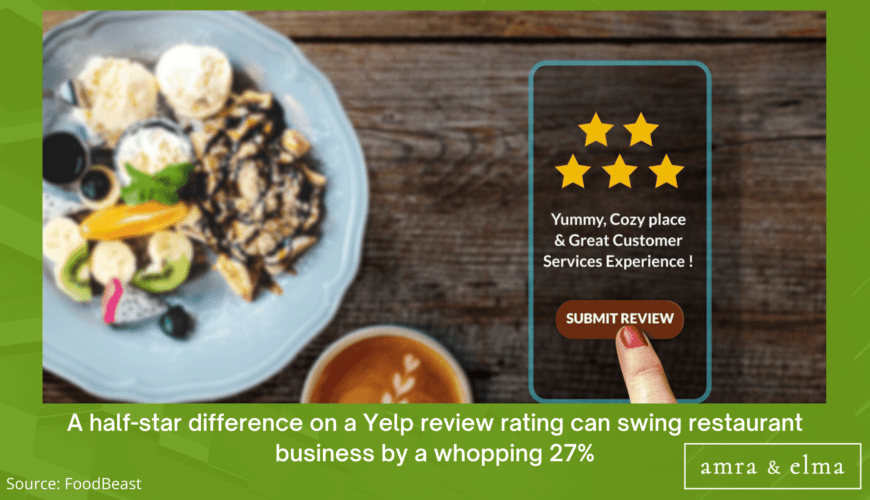
Food Marketing Statistics #8: 60% of U.S. consumers order delivery or takeout once a week.
According to the official stats from the NPD group, 60% of U.S. consumers order delivery or takeout once a week. That’s up from just over 50% five years ago. The most popular food to order for delivery or takeout is pizza, followed by Chinese food, burgers, and chicken. The growth in delivery and takeout order is being driven by several factors, including the increasing popularity of food delivery apps, the growing number of people living in cities, and the rise of fast-casual restaurants. Delivery and takeout orders are becoming more mainstream as it becomes more convenient and affordable. These trends are likely to continue in the coming years, making delivery and takeout an increasingly important part of the restaurant industry.

Food Marketing Statistics #9: 34% of consumers spend at least $50 per order when ordering food online.
According to a report from Statista, 34% of consumers spend at least $50 per order when ordering food online. This indicates that food delivery is becoming a popular option for those looking for convenience and ease. In addition, the report found that the average consumer spends about $207 per month on food delivery. This number is expected to grow as more people become aware of the benefits of ordering food online. Ordering food online can save time and money, and it can also be a great way to support local businesses. With the popularity of food delivery services on the rise, more consumers will likely take advantage of this convenient option.
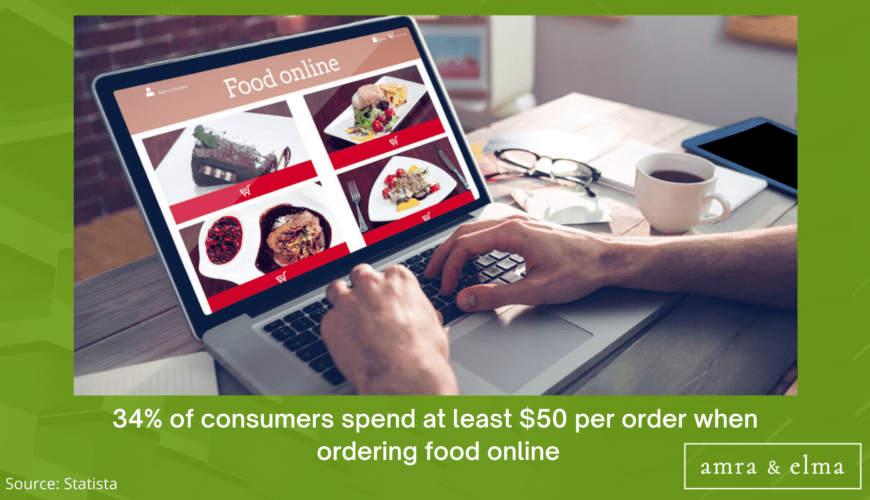
Food Marketing Statistics #10: Digital ordering and delivery has grown 300% faster than dine-in traffic since 2014.
A study from the NRN group found that digital ordering and delivery has grown 300% faster than dine-in traffic since 2014. While the study did not reveal the reasons behind this trend, the convenience and flexibility of digital ordering have likely made it a popular choice for busy consumers. The study found that delivery now accounts for 18% of all restaurant sales, up from just 5% in 2014. This growth is likely to continue as more restaurants invest in digital ordering and delivery solutions. With the rapid growth of digital orders, it is clear that restaurants need to adapt their business models to meet consumers’ demands.
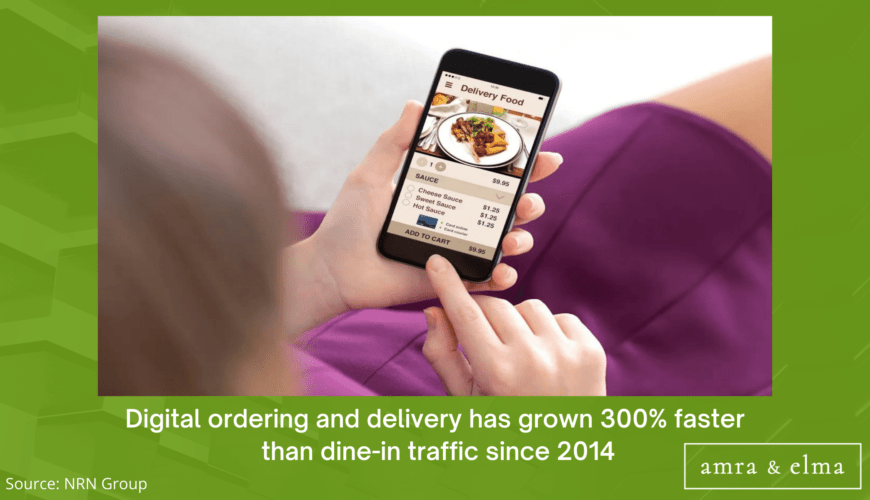
Food Marketing Statistics #11: 70% of restaurant operators in the US said that offering delivery had generated incremental sales.
According to the latest restaurant statistics, 70% of restaurant operators in the US said that offering delivery had generated incremental sales. This is a significant increase from previous years, and it’s likely due to the growing popularity of delivery apps like Uber Eats and DoorDash. Delivery provides a convenient option for busy customers, and it can also help boost sales during slower times of the day. In addition, delivery can help reach new customers who may not have been aware of your restaurant before. If you’re thinking about adding delivery to your restaurant, these statistics show that it could be a worthwhile investment.

Food Marketing Statistics #12: Orders placed via smartphone and mobile apps are a $47 billion industry.
According to Statista, orders placed via smartphone and mobile apps will be a $47 billion industry in 2021. This figure is expected to grow to $77.2 billion by 2025, representing a compound annual growth rate of 11.1%. When broken down by region, North America is expected to generate the largest revenue share of 37.3% by 2025. The growing popularity of mobile commerce is being driven by several factors, including the increasing availability of high-speed mobile data networks, the proliferation of smartphones and tablets, and the growing trend of Consumers using their devices for more than just making calls and sending text messages. In addition, the COVID-19 pandemic has resulted in a significant increase in the use of mobile commerce platforms as consumers seek out contactless shopping options. As the mobile commerce industry continues to grow, businesses will need to increasingly focus on developing robust and user-friendly mobile apps to remain competitive.
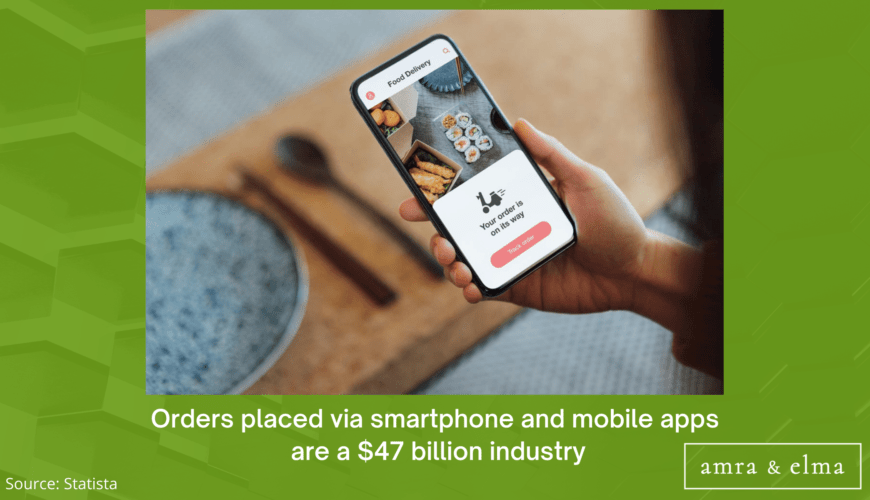
Food Marketing Statistics #13: Over 80% of restaurants in US are turning to technology.
According to the National Restaurant Association (NRA), over 80% of restaurants in the US are turning to technology—like online ordering, reservation and inventory apps, and restaurant analytics—now more than ever to help them run their business successfully and efficiently. The NRA’s Restaurant Industry Forecast for 2020 states that 41% of restaurants use or will soon use handheld server tablets. As customers’ expectations for seamless service continue to rise, it’s clear that restaurants need to embrace technology to remain competitive. By streamlining operations and improving communication between front-of-house and back-of-house staff, restaurant owners can create a better dining experience for their guests while increasing efficiency and reducing costs.
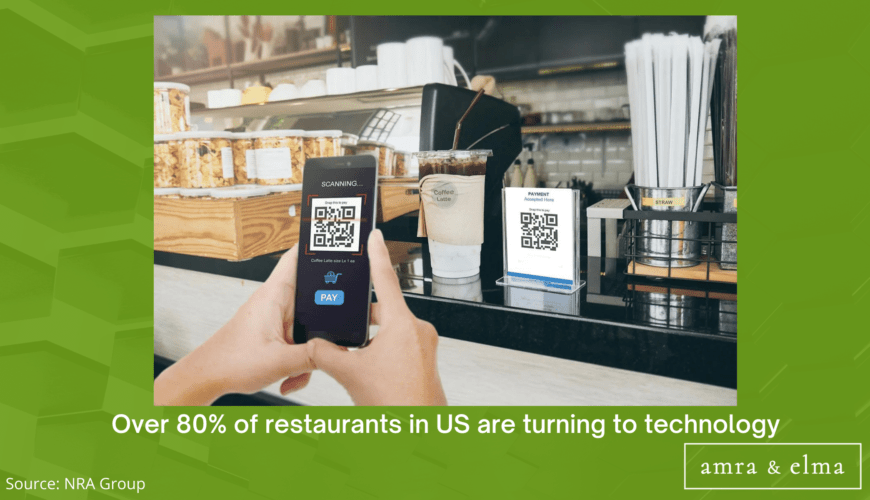
Food Marketing Statistics #14: Americans spend around 12.5% of their income buying food.
According to the official statistics from the Bureau of Labor Statistics, Americans spend around 12.5% of their income buying food. This includes both groceries and eating out at restaurants. People’s spending on food varies based on several factors, such as income level, family size, and location. In general, low-income households pay a higher percentage of their income on food than high-income households. Families with children also tend to spend more on food than those without children. And people who live in rural areas typically pay less for food than those who live in urban areas. Despite these variations, the average American still spends a significant chunk of their income feeding themselves and their families.
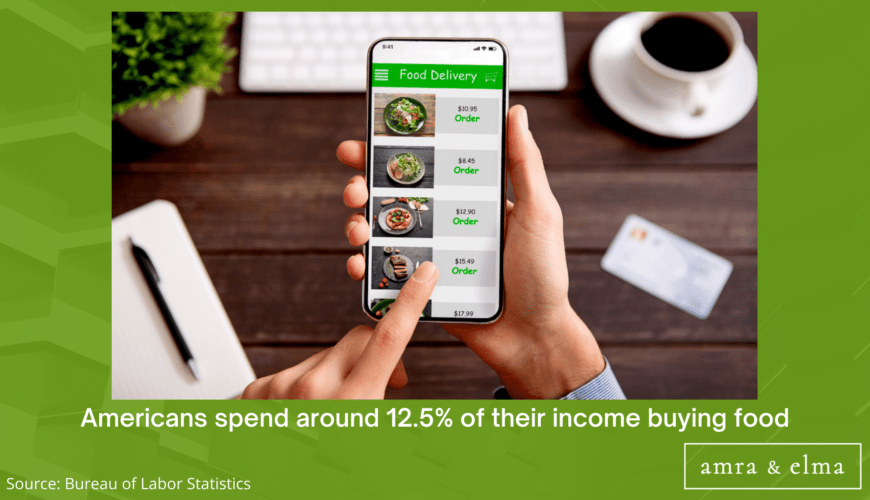
Food Marketing Statistics #15: Over half (68.3%) of restaurant customers are willing to spend more at locations with sustainable practices.
According to the official stats from ChefHero, over half (68.3%) of restaurant customers are willing to spend more at locations with sustainable practices. This indicates that sustainability is not only good for the environment but it’s also good for business. There are many ways to make a restaurant more sustainable, such as using recycled and recyclable materials, composting food waste, and investing in energy-efficient kitchen equipment. Many of these changes can be made at little or no cost, and they can significantly impact the bottom line. Furthermore, customers are becoming increasingly aware of the importance of sustainability, and they’re more likely to patronize businesses that share their values. As the restaurant industry grows, it’s important to keep sustainability in mind to attract and retain customers.
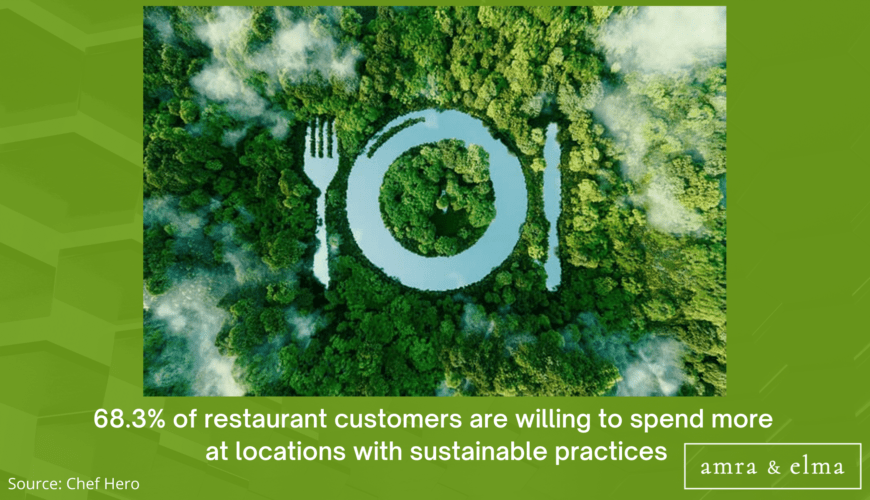
Food Marketing Statistics #16: 86% of Millennials will try a new restaurant after seeing their content online.
According to the official stats from Facebook, 86% of Millennials will try a new restaurant after seeing their content online. It’s no wonder, then, that restaurateurs are increasingly turning to social media to market their businesses. A well-crafted post can reach a vast audience and whet appetites for what’s on the menu. And with food delivery apps making it easier than ever to enjoy a meal from the comfort of home, there’s no reason not to take advantage of this marketing opportunity. Whether it’s a compelling photo of a new dish or a mouthwatering video of a chef in action, food-related content has the power to draw in customers and boost business.
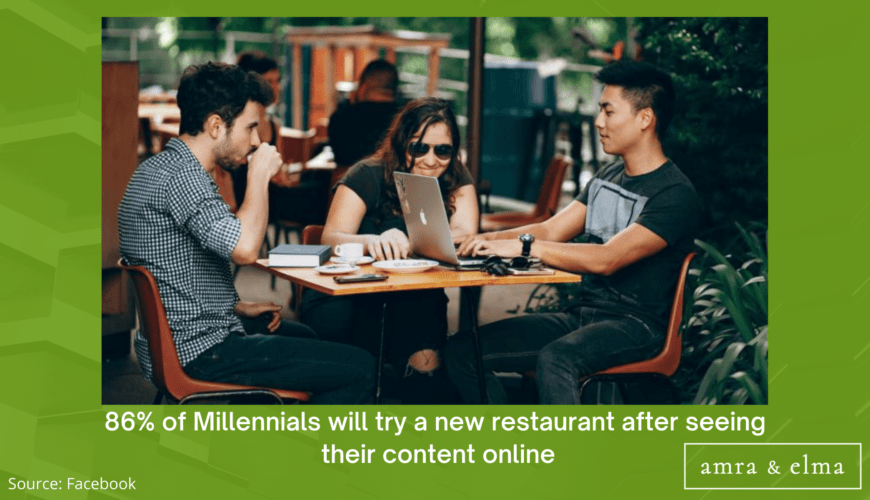
Food Marketing Statistics #17: 82% Of Millennials Turn To YouTube For Food & Beverage-Related Tips.
According to the official Google data, YouTube is one of the most popular sources of information for food and beverage-related tips for millennials. In fact, 82% of millennials say that they turn to YouTube when looking for new recipes or cooking tips. This is likely because YouTube offers a wealth of information on any topic, including food and drink. There are thousands of channels dedicated to food and drink-related content, and many of them feature videos that are both informative and entertaining. In addition, YouTube is a highly visual platform, making it an ideal source of information for those who prefer to learn by watching videos. With so much helpful information available, it’s no wonder that YouTube is one of the most popular information sources for millennials interested in food and drink.

Food Marketing Statistics #18: Food content has generated nearly 51 billion views on YouTube.
According to the official Youtube statistics by Hootsuite, food content has generated nearly 51 billion views. This is an incredible amount of engagement and indicates that people are interested in watching videos about food. There are several reasons why food videos are so popular. First, they can be incredibly visually appealing. Watching someone cook a delicious meal or create an intricate dish can be fascinating and motivating. Second, food videos often tap into our emotions. They can make us laugh, feel nostalgic, or even inspire us to try something new. Finally, food videos can be a great way to learn about different cultures and cuisines. By watching cooking shows or vlogs, we can better understand how people around the world eat and live. Food videos offer a unique window into the human experience in many ways.
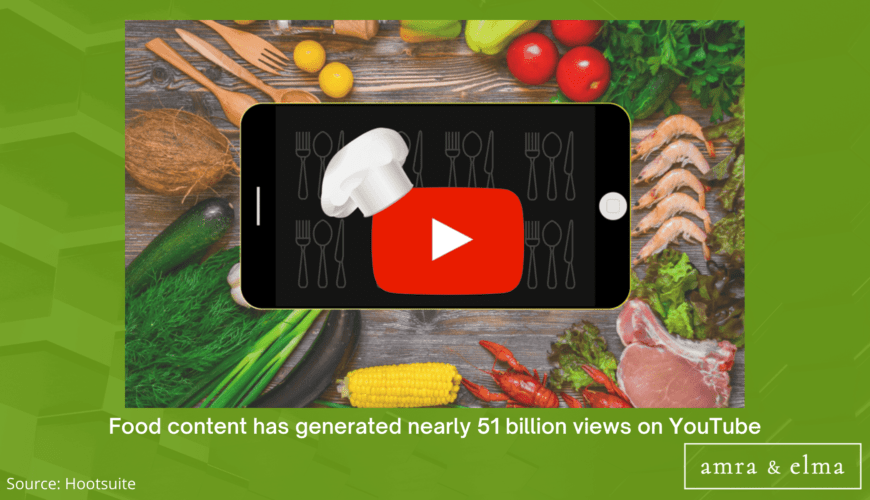
Food Marketing Statistics #19: 81% of customers (and 89% of millennials) want to know more about how the food is prepared and to explore “behind the scenes footage.”
According to the Nielsen report, 81% of customers (and 89% of millennials) want to know more about how the food is prepared and explore “behind the scenes footage.” For restaurants, this provides an opportunity to connect with their customers deeper and create loyalty. Customers want to patronize businesses that they feel good about, willing to pay more for transparency. In addition, behind-the-scenes footage helps customers feel closer to the company and its employees. When customers have a personal connection to a business, they are more likely to become lifelong fans. Therefore, providing behind-the-scenes access is good for business and builds customer relationships.

Food Marketing Statistics #20: 79% of customers trust blogs for information about food.
According to Stella Rising, a food blog research and marketing firm, 79% of customers trust blogs for information about food. This is likely because customers feel that they can relate to the blogger and that the blogger has a similar taste to theirs. In addition, customers may appreciate the level of detail and thoughtfulness that goes into a blog post about food. For example, a blog post might explain why a particular ingredient was used in a dish or how a cooking method results in a specific flavor profile. This level of detail can help the reader to understand the dish in a new way and perhaps even replicate it at home. It is no surprise that food blogs have become so popular in recent years.
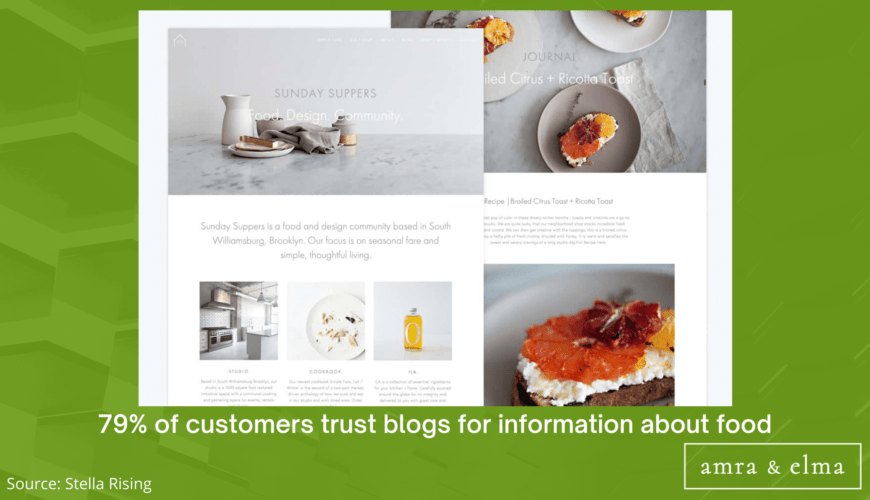
Food Marketing Statistics #21: 45% of consumers say that offering mobile ordering or loyalty programs would encourage them to use online ordering services more often.
According to the latest NRN report, 45% of consumers say that offering mobile ordering or loyalty programs would encourage them to use online ordering services more often. Additionally, close to 60% of college students say they would buy from a food brand that sent them a coupon through Snapchat. These findings suggest a significant opportunity for food brands to increase their online sales by implementing mobile ordering and loyalty programs. To take advantage of this opportunity, brands need to focus on creating an intuitive and user-friendly ordering experience. Additionally, it is important to offer incentives to drive customers to use the mobile ordering service. For example, offering discounts or rewards points for orders placed through the mobile app can effectively encourage customers to use the service.
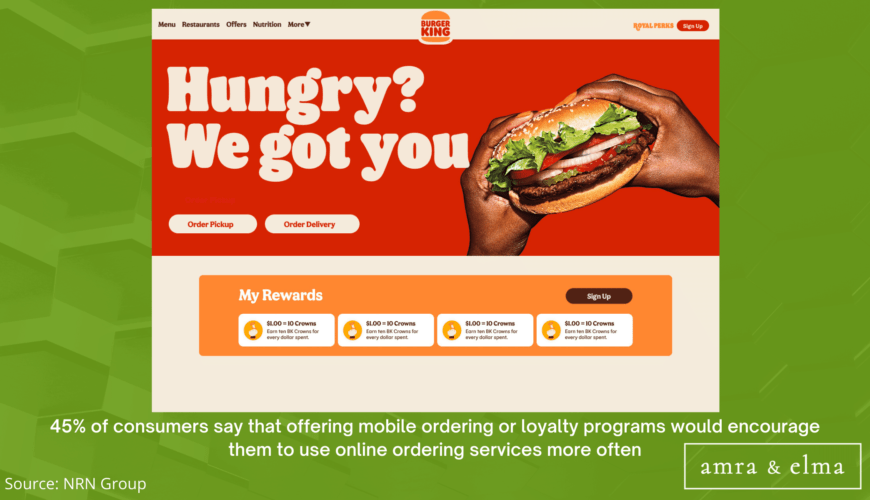
According to Sprout Social, 67% of restaurants paid for at least one social media ad or campaign in 2021. This is up from 63% in 2020 and 60% in 2019. The most popular platforms for restaurant ads are Facebook (61%), Instagram (38%), and Twitter (11%). The most common type of restaurant ad is a boosted post (30%), followed by a video ad (28%) and an image ad (27%). Boosted posts are given more visibility on a platform by paying to have them appear in more people’s feeds. Video ads are short videos that businesses pay to have played before other videos on a platform. Image ads are static images that companies pay to have displayed on a platform. Restaurants use social media ads to reach new customers, promote their brand, and boost sales.
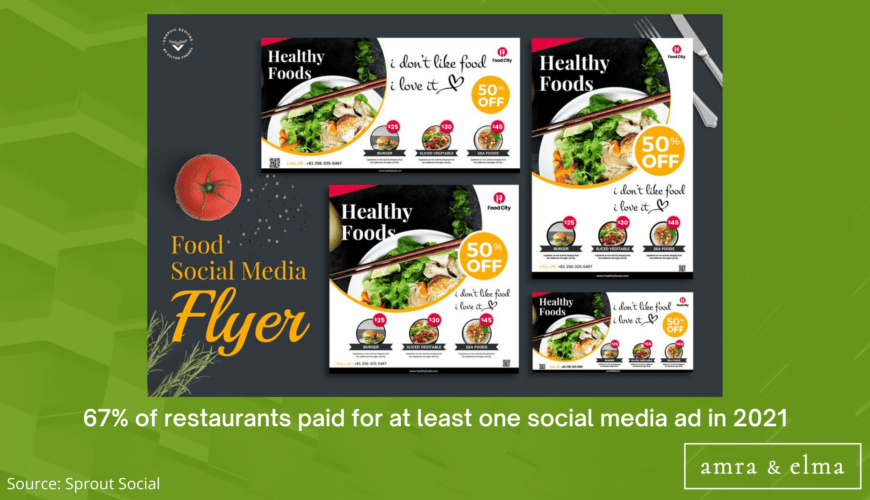
A report from Toast, a restaurant technology platform, found that 43% of restaurants use Instagram as their social media platform of choice. The report surveyed 1,000 restaurant owners and operators across the United States. Instagram was found to be the most popular social media platform among respondents, followed by Facebook (42%), Twitter (17%), and Snapchat (3%). The report also found that restaurants use social media to connect with customers, promote their brand, and drive sales. For example, nearly half of respondents said they use social media to post specials or promotions, and one-third said they use social media to post new menu items. In addition, nearly two-thirds of respondents said they believe social media positively impacts their business. These findings suggest that restaurants increasingly use social media to reach customers and grow their business.
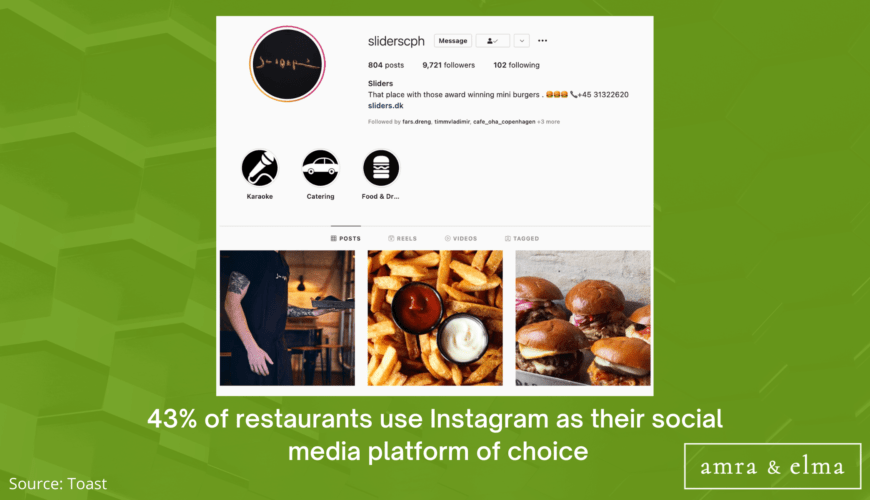
Food Marketing Statistics #24: 6 out of the 10 most popular brands on Facebook are in the food and beverage industry.
According to the official Facebook stats, 6 out of the ten most popular brands on Facebook are in the food and beverage industry. The top three are Coca-Cola, Starbucks, and Red Bull. This is not surprising, as these companies have long been leaders in marketing and social media engagement. However, it is interesting to see that the food and beverage industry has a strong Facebook presence. This may be because people often share photos and experiences related to food and drinks, creating a natural connection between these brands and their customers. In addition, many foods and beverage companies have developed highly effective social media campaigns that have helped increase their reach and engagement levels. As we continue to see the growth of social media, we will likely see even more food and beverage brands succeeding on platforms like Facebook.
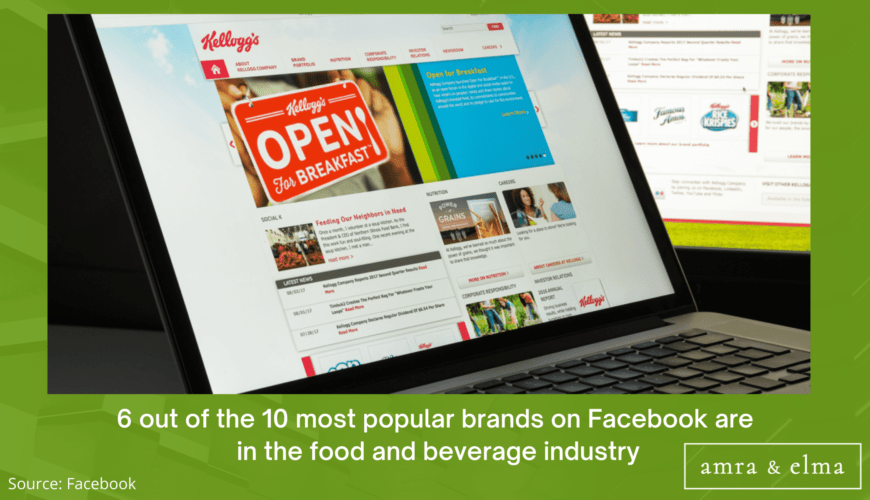
Food Marketing Statistics #25: Nestlé is the biggest food advertiser in the United States, with $2.4 billion invested in advertising in 2022.
According to Statista, the Swiss food and drink company Nestlé is the biggest advertiser in the United States when it comes to food and beverages. In 2022, Nestlé was estimated to have invested around 2.4 billion U.S. dollars in advertising across all channels in the United States. This includes traditional media such as television and radio and digital platforms such as social media, websites, and apps. Nestlé’s brands have some of the most popular and well-known food and beverage products in the world, such as KitKat, Nescafé, and Gerber baby food. The company’s advertising budget is likely to continue to be one of the largest in the United States in the coming years.

The Future of Food Marketing
These essential food marketing statistics provide insights into the current state of the food industry and where it is headed. The future of food marketing is likely to be shaped by several factors, including advances in technology, changes in consumer tastes and preferences, and the increasing globalization of the food industry. Technology will play a significant role in food marketing, with new platforms and tools emerging. This means that companies must be agile and adaptable to keep up with the latest trends. Changes in consumer behavior will also impact food marketing, as people increasingly look for healthy, sustainable, and ethical options. The globalization of the food industry means that companies will need to be more aware than ever of cultural differences and sensitivities. In conclusion, the future of food marketing is likely to be fascinating and dynamic, with plenty of opportunities for those willing to embrace change.
Why Is Digital Marketing for Food Products So Important?
Digital marketing for food products is an important aspect of the food industry. It allows companies to reach a wider audience and create a connection with consumers. There are many different types of digital marketing for food products, and each has its benefits and purposes.
One type of digital marketing for food products is social media. Social media platforms allow companies to create profiles and pages, which consumers can follow. Companies can then post updates and images about their products, as well as interact with consumers by responding to comments and messages. Social media is a great way to connect with consumers and create a relationship with them.
Another type of digital marketing for food products is search engine optimization (SEO). SEO helps companies rank higher in search engine results pages (SERPs), which means that their products will be more likely to be seen by consumers. Companies can do SEO themselves, or they can hire a company to help them with it. SEO is a great strategy for digital marketing for food products, and an effective way to get more visibility for a company’s products.
Finally, another type of digital marketing for food products is email marketing. Email marketing allows companies to send emails to consumers who have subscribed to their mailing lists. The emails can contain images, text, and links to the company’s website. Email marketing is a great part of digital marketing for food products and a measurable way of keeping in touch with consumers and letting them know about new products or sales.
Digital marketing for food products is an important part of the food industry. It allows companies to reach a wider audience and create a connection with consumers. There are many different types of digital marketing for food products, and each has its benefits and purposes.
There are many reasons why digital marketing for food products is important. One of the most important reasons is that it allows businesses to reach a wider audience with their message. With digital marketing for food products, businesses can target specific audiences based on their interests and demographics. This ensures that the message reaches the right people, which can lead to increased sales and profits.
Another reason why digital marketing for food products is important is that it allows businesses to track their results. Through digital marketing for food products, businesses can track how many people saw their advertisement, how many clicked on it, and how many purchased the product. This information helps businesses to gauge the effectiveness of their advertising campaigns and make necessary changes to improve their results.
Digital marketing for food products is also an affordable way to promote food and beverage products. Compared to traditional advertising methods such as print or television advertising, digital marketing for food products is much more affordable. This makes it possible for businesses of all sizes to use digital marketing to promote their products.
Overall, there are many reasons why digital marketing for food products is important. By using digital marketing for food products, businesses can reach a wider audience, track their results, and affordably promote their products.
TOP FOOD MARKETING STATISTICS IN 2024- FAQ:
What food company spends the most on advertising?
According to Statista, the Swiss food and drink company Nestlé is the biggest advertiser in the United States when it comes to food and beverages. In 2021, Nestlé was estimated to have invested around 2.4 billion U.S. dollars in advertising across all channels in the United States. This includes traditional media such as television and radio and digital platforms such as social media, websites, and apps. Nestlé’s brands have some of the most popular and well-known food and beverage products in the world, such as KitKat, Nescafé, and Gerber baby food.
How much money is spent on food advertising in the US?
In 2022, per Statista, measured media spending within the United States food, beverages, and candy sector totaled approximately $7.5 billion U.S. dollars, while restaurants allocated an additional $9 billion dollars towards advertising efforts. Collectively, these two segments accounted for nearly one-third of the total expenditure within the retail sector, underscoring the significant investment in advertising within the food industry. Moreover, the U.S. canned, frozen, and preserved fruits, vegetables, and specialty foods sector witnessed an additional ad spend of nearly $1 billion dollars in the same year. These substantial investments highlight the competitive landscape of food advertising in the United States, as companies strive to capture consumers’ attention and drive sales in a crowded marketplace. Food advertising serves as a pivotal tool for companies seeking to communicate the features and benefits of their products, ultimately influencing consumer purchasing decisions. Food advertising can take various forms, including television commercials, print advertisements in magazines or newspapers, digital ads on websites and social media platforms, outdoor billboards, in-store displays, product packaging, and sponsored content. Whether through captivating commercials, eye-catching in-store displays, or innovative packaging designs, these marketing tactics aim to captivate consumers’ attention and drive sales. In conclusion, the data from 2022 illustrates the substantial investment made by food companies and restaurants in advertising within the United States to stay relevant, drive brand awareness and increase sales.
How is marketing used in the food industry?
Food marketing takes many forms and can involve building relationships with customers, raising brand awareness, developing new products, promoting them through advertising, and even paying grocery stores for prominent shelf space, all with the goal of promoting sales.
What food is advertised the most?
The most frequently advertised food product is high sugar breakfast cereal. There were no advertisements for fruits or vegetables. Several other studies have documented that the foods promoted on US children’s television are predominantly high in sugar and fat, with almost no references to fruits or vegetables.
What is Foodservice Marketing?
Foodservice marketing refers to promoting and selling food and beverage products to customers through various channels such as restaurants, food trucks, catering services, and more. Foodservice marketing is a specialized field that involves a strategic approach to drawing in potential customers, increasing sales, and building brand awareness in the highly competitive food and beverage market.
One of the essential components of foodservice marketing is identifying the target customer demographic. Understanding the preferences and needs of the target audience is crucial in creating a solid marketing strategy that resonates with them. Age, gender, lifestyle, dietary restrictions, and cultural differences are all factors that influence a customer’s purchasing decision. Marketers need to consider these aspects when creating campaigns and promotions for various food and beverage products.
Apart from the target audience, product differentiation is another critical component of foodservice marketing. With an extensive range of food and beverage options available in the market, it is imperative to differentiate one’s product from the competition. A distinctive product offering that meets and surpasses customer expectations can help to create a customer base that is loyal to a particular brand.
In foodservice marketing, various channels can be utilized to reach the target audience, such as social media, email marketing, paid advertising, and more. Choosing the right track and consistently delivering quality content can help build a brand’s credibility and keep customers engaged. Furthermore, leveraging customer feedback through online reviews, surveys, and focus groups can help marketers gain invaluable insights into their target audience and tailor their marketing strategy accordingly.
How popular is Foodservice Marketing?
Foodservice marketing is a prevalent and crucial aspect of the food industry. It is a strategic approach designed to increase consumer demand and customer loyalty for food-related products and services. Foodservice marketing has become an essential marketing tool because it gives companies the unique advantage of creating brand awareness, promoting food products and services, and increasing sales.
The widespread use of foodservice marketing significantly impacts the food industry and the overall economy. Foodservice marketing is used by various companies, including fast-food chains and high-end restaurants, to promote their products and services. These marketing efforts can include television commercials, online ads, social media campaigns, and even word of mouth.
Foodservice marketing has become increasingly popular due to the rise of technological innovations and social media platforms. With platforms like Instagram and TikTok, food companies can showcase their products to a broader audience, increasing the chance of reaching potential customers. These platforms allow businesses to develop their brand identity, interact with customers, provide updates about their products and services, and ultimately grow their business.
However, foodservice marketing has its challenges. In recent years, food companies have been under intense scrutiny for their marketing practices, mainly targeting children and promoting unhealthy products. As a result, companies have shifted their focus toward developing healthier food options, promoting sustainability and eco-friendliness, and creating inclusive marketing strategies that align with their customers’ values.
In conclusion, the popularity of foodservice marketing must be considered. Foodservice marketing can create brand awareness, increase sales and customer loyalty, and promote healthy and sustainable food options, and it has become an indispensable aspect of the food industry.

